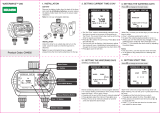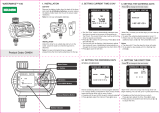
Table of Contents
Introduction.....................................................................1
Device Overview......................................................................... 1
Touchscreen Tips.................................................................. 1
Locking and Unlocking the Touchscreen.......................... 1
Using the Controls Menu....................................................... 1
Side Swipe Control Tips.........................................................1
Icons........................................................................................... 1
Smart Features............................................................... 2
Pairing Your Smartphone........................................................... 2
Connected Features................................................................... 2
Phone Notifications................................................................ 2
Enabling Bluetooth Notifications....................................... 2
Viewing Notifications......................................................... 2
Managing Notifications...................................................... 2
Turning Off Bluetooth Technology.................................... 2
Using Do Not Disturb Mode................................................... 2
Locating a Lost Smartphone.................................................. 3
Connect IQ Features.................................................................. 3
Downloading Connect IQ Features........................................ 3
Downloading Connect IQ Features Using Your Computer.... 3
Garmin Pay™.................................................................. 3
Setting Up Your Garmin Pay Wallet........................................... 3
Paying for a Purchase Using Your Watch.................................. 3
Adding a Card to Your Garmin Pay Wallet................................. 3
Managing Your Garmin Pay Wallet........................................3
Changing Your Garmin Pay Passcode....................................... 4
Heart Rate Features....................................................... 4
Wrist-based Heart Rate.............................................................. 4
Wearing the Device and Heart Rate...................................... 4
Tips for Erratic Heart Rate Data.............................................4
Viewing the Heart Rate Widget.............................................. 4
Broadcasting Heart Rate to Garmin Devices......................... 4
Turning Off the Wrist Heart Rate Monitor.............................. 4
About Heart Rate Zones............................................................. 4
Setting Your Heart Rate Zones.............................................. 4
Heart Rate Zone Calculations................................................ 5
About VO2 Max. Estimates.........................................................5
Getting Your VO2 Max. Estimate........................................... 5
Activity Tracking............................................................ 5
Auto Goal.................................................................................... 5
Using the Move Alert.................................................................. 5
Sleep Tracking............................................................................ 5
Intensity Minutes......................................................................... 5
Earning Intensity Minutes.......................................................6
Garmin Move IQ™...................................................................... 6
Activity Tracking Settings............................................................6
Turning Off Activity Tracking.................................................. 6
Widgets........................................................................... 6
Viewing Widgets......................................................................... 6
Customizing the Widget Loop................................................ 6
About My Day............................................................................. 6
Viewing the Weather Widget...................................................... 6
Heart Rate Variability and Stress Level...................................... 6
Using the Stress Level Widget............................................... 7
VIRB Remote.............................................................................. 7
Controlling a VIRB Action Camera.........................................7
Music Controls............................................................................ 7
Controlling Music Playback.................................................... 7
Apps and Activities........................................................ 7
Starting an Activity...................................................................... 7
Tips for Recording Activities.................................................. 7
Stopping an Activity.................................................................... 7
Adding a Custom Activity
............................................................ 8
Adding or Removing a Favorite Activity...................................... 8
Indoor Activities.......................................................................... 8
Recording a Strength Training Activity...................................8
Calibrating the Treadmill Distance......................................... 8
Outdoor Activities........................................................................8
Going for a Run......................................................................8
Going for a Ride..................................................................... 8
Viewing Your Ski Runs.......................................................... 9
Swimming................................................................................... 9
Going for a Pool Swim........................................................... 9
Setting the Pool Size..............................................................9
Swim Terminology................................................................. 9
Golfing........................................................................................ 9
Playing Golf............................................................................9
Hole Information.....................................................................9
Viewing Layup and Dogleg Distances................................... 9
Using the Odometer............................................................... 9
Keeping Score....................................................................... 9
Reviewing Scores................................................................ 10
Measuring a Shot................................................................. 10
Training......................................................................... 10
Setting Up Your User Profile.....................................................10
Fitness Goals....................................................................... 10
Workouts...................................................................................10
Following a Workout............................................................ 10
Using Garmin Connect Training Plans.................................10
Starting Today's Workout................................................ 10
Viewing Scheduled Workouts......................................... 10
Personal Records..................................................................... 10
Viewing Your Personal Records.......................................... 10
Restoring a Personal Record............................................... 11
Clearing a Personal Record................................................. 11
Clearing All Personal Records............................................. 11
Navigation..................................................................... 11
Marking Your Location.............................................................. 11
Deleting a Location.............................................................. 11
Navigating to a Saved Location................................................ 11
Navigating Back to Start........................................................... 11
Stopping Navigation................................................................. 11
Compass...................................................................................11
Calibrating the Compass Manually...................................... 11
History........................................................................... 11
Using History............................................................................ 12
Viewing Your Time in Each Heart Rate Zone...................... 12
Garmin Connect........................................................................12
Using Garmin Connect Mobile............................................. 12
Using Garmin Connect on Your Computer.......................... 12
Customizing Your Device............................................ 12
Changing the Watch Face........................................................ 12
Creating a Custom Watch Face........................................... 12
Customizing the Controls Menu................................................13
Activities and App Settings....................................................... 13
Customizing the Data Screens............................................ 13
Alerts.................................................................................... 13
Setting an Alert................................................................13
Auto Lap...............................................................................14
Marking Laps Using the Auto Lap Feature..................... 14
Using Auto Pause®............................................................. 14
Using Auto Scroll................................................................. 14
Phone and Bluetooth Settings.................................................. 14
System Settings........................................................................ 14
Time Settings....................................................................... 14
Time Zones..................................................................... 14
Setting the Time Manually...............................................14
Table of Contents i






















